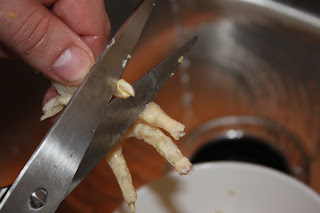Spring is all about planting and hatching new life. Summer is our busy growing and processing season. Autumn focuses on the harvest and putting the garden to bed for the winter. So, now what?
The shorter amount of daylight means the chickens, guineas, and turkeys spend less time outdoors (they are let out around dawn- 6:30ish AM and locked up at dusk- 5:00ish PM). Even though the temperatures get very cold, the birds want out! They don't mind the snow as long as they don't have to trudge through it (so, we snow blow their yard each and every storm). I just keep an eye out for frostbite on the birds with the larger combs, especially the roosters. A little petroleum jelly helps insulate the comb.
The bees have been "tucked in" for the winter and we will wait to check on them until January. They will huddle together to keep the hive in the 50's-60's. They will rotate positions so the bees on the outside of the cluster will move in for a while. In late January, the bees will work together to bring the temperature up in order to start rearing brood.
In the garden, we still have kale, brussell sprouts, and carrots. The brussell sprouts and kale are cold hardy and the carrots are under mulch. The mulch will help prevent the ground from freezing allowing us to harvest fresh carrots throughout the winter. Without the mulch, we would just have to wait until spring to harvest the delicious carrots (cold temperatures encourage the carrots to convert their starches into sugars making them sweeter). Meanwhile, the garlic planted last month is also heavily mulched along with the perennials as they wait for spring.
In the house, we are enjoying the fruits (and veggies) of our labor. During the growing season, we put food by for winter use. Our pantry is lined with items we canned or dried months ago; and the freezers are stocked with our turkey, chicken, and homemade stock, along with fruit and veggies. We will use up the rest of the maple syrup made last year (and look forward to this coming sugaring season). Sitting by the wood stove, enjoying warm, homemade, and homegrown food, we pour through the seed and hatchery catalogs which arrive regularly in the mail this time of year and are busy making plans for 2012. Already, the calendar is quickly filling up! Winter allows us a time to rest, but that doesn't mean we stop!
The shorter amount of daylight means the chickens, guineas, and turkeys spend less time outdoors (they are let out around dawn- 6:30ish AM and locked up at dusk- 5:00ish PM). Even though the temperatures get very cold, the birds want out! They don't mind the snow as long as they don't have to trudge through it (so, we snow blow their yard each and every storm). I just keep an eye out for frostbite on the birds with the larger combs, especially the roosters. A little petroleum jelly helps insulate the comb.
The bees have been "tucked in" for the winter and we will wait to check on them until January. They will huddle together to keep the hive in the 50's-60's. They will rotate positions so the bees on the outside of the cluster will move in for a while. In late January, the bees will work together to bring the temperature up in order to start rearing brood.
In the garden, we still have kale, brussell sprouts, and carrots. The brussell sprouts and kale are cold hardy and the carrots are under mulch. The mulch will help prevent the ground from freezing allowing us to harvest fresh carrots throughout the winter. Without the mulch, we would just have to wait until spring to harvest the delicious carrots (cold temperatures encourage the carrots to convert their starches into sugars making them sweeter). Meanwhile, the garlic planted last month is also heavily mulched along with the perennials as they wait for spring.
In the house, we are enjoying the fruits (and veggies) of our labor. During the growing season, we put food by for winter use. Our pantry is lined with items we canned or dried months ago; and the freezers are stocked with our turkey, chicken, and homemade stock, along with fruit and veggies. We will use up the rest of the maple syrup made last year (and look forward to this coming sugaring season). Sitting by the wood stove, enjoying warm, homemade, and homegrown food, we pour through the seed and hatchery catalogs which arrive regularly in the mail this time of year and are busy making plans for 2012. Already, the calendar is quickly filling up! Winter allows us a time to rest, but that doesn't mean we stop!

























